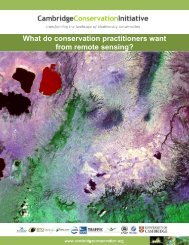CONSERVING BIODIVERSITY & DELIVERING ECOSYSTEM SERVICES
conserving biodiversity & delivering ecosystem services
conserving biodiversity & delivering ecosystem services
Create successful ePaper yourself
Turn your PDF publications into a flip-book with our unique Google optimized e-Paper software.
(Jyotendra Jyu Thakuri)<br />
Some facts and figures<br />
AREA: 21,000 ha<br />
PROTECTION STATUS: Wildlife Reserve (protected) and barrage (unprotected)<br />
CONSERVATION STATUS: high pressures, unfavourable state, medium response<br />
MAIN METHODS FOR ASSESSING <strong>ECOSYSTEM</strong> <strong>SERVICES</strong>: stakeholder workshops (9), key informant<br />
meetings, rapid appraisal, household surveys (154)<br />
SURVEY STAFF: 3<br />
SURVEY TIME: 30 person days<br />
The Site: This Important Bird Area (IBA) was created as a result of the construction of the Koshi Barrage in 1958, which provides<br />
water to India. It was designated as a Ramsar Site in 1987. This site is an IBA because it is a very important wetland for migrating<br />
waders and waterfowl, and is a critical site for the globally threatened Swamp Francolin. It also harbours other threatened<br />
species, including the Ganges River Dolphin and holds the last remaining population of wild Asian Water Buffalo in the country.<br />
The Issues: The majority of the 16,280 households living inside the buffer zone cultivate rice crops and utilise the reserve for<br />
other resources, including fish, fodder and firewood. 61% are classified as wetland-dependent communities. However,<br />
reduction in the numbers of waterbirds indicates a reduction in fish with severe consequences for both wildlife and humans.<br />
This study: The value of ecosystem services delivered by the site was compared to those delivered by comparable habitats<br />
outside the reserve. Local people benefit from fishing and harvesting grasses which may be having a negative impact on the<br />
biodiversity. Benefits from international tourism are low but significant. However, they mainly accrue nationally.<br />
Interpreting the results: Local people are highly dependent on the natural resources of the reserve and it provides many more<br />
benefits than the surrounding areas outside of the Protected Area which have been heavily degraded. However, improving the<br />
management of the site for important bird species will require more regulated harvesting within key areas of the reserve. Where<br />
costs for local people are significant, initiatives may be needed which help redress the imbalance. For example, alternative<br />
livelihoods projects based on use of invasive plant species or fish farming and engagement in the tourism sector may help to<br />
reduce pressures whilst giving local people a fair share of the benefits.




